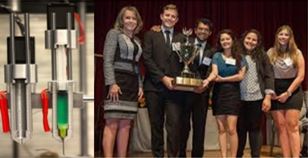The Design Process
A maker identifies unmet needs or wants (i.e. opportunities), translates customer wants into product or process characteristics, specifies design requirements and constraints, converts the product characteristics into a hand-drawn sketch, then into a computer-aided drawing (CAD) or set of drawings, determines what the necessary parts are and how the parts should be assembled, and uses whatever means are available and/or necessary to construct a prototype. In the words of Willy Wonka, "We are the makers, and we are the dreamers of dreams." [1] Every inventor is a maker. Although not all makers are inventors, a much higher percentage of makers are either inventors or innovators than is found amongst engineers, let alone the general population. As engineer B'Elanna Torres said during an episode of Star Trek Voyager, "It may be the warriors who get the glory. But it's the engineers who build societies. Don't forget that." [2]
[1] Willy Wonka and the Chocolate Factory, Paramount Pictures, 1971, Go to reference [1].
[2] "Flesh and Blood", StarTrek Voyager Episode 7x9/10, Nov. 29, 2000, Go to reference [2].
- Ideation
- Innovation & Creativity
- Question Formulation Technique (QFT)
- Idea to Concept Drawing
- Organizing Information / Concept Maps
- Augmented Reality (Visualization of the Problem or Design)
- Design Thinking
- Systems Design Thinking
- Customer Engagement, Market Analysis, and Pain Points
- Suspending Judgment During Market Evaluation
- Defining the Need
- Value Proposition
- Assessing Value
- Impact Thinking
- Assessing Impact
- Defining Requirements
- Elevator Pitch
- Shark Tank (Communicating Design Value)
- Team Building
- Product Development
- Designing and Making the Prototype
- Product Design Reviews
- ABET/KEEN Outcomes Assessment
As the development and refinement of prototypes is critical to the development of an entrepreneurially-minded engineer, it is worthwhile to list the steps in the development of a salable product below.
- Identification of an opportunity in terms of customer needs, wants, and/or wishes;
- Assessment of the impact that such an opportunity might present;
- Definition of the problem;
- A brainstorming process to identify the questions and issues for a product and/or process (ref. 2);
- Categorization of the questions and issues into technical/engineering, economic, environmental, safety, health, legal, regulatory, quality, and social impact (ref. 2);
- Conversion of 4) and 5) into a set of design constraints;
- One or more sketches as part of the initial ideation of a solution;
- Definition of the sketch to include all process and product variables in a familiar engineering notation;
- Listing all process and product knowns and unknowns so that the engineer knows how many equations must be written;
- Application of the conservation laws of mass, energy, and momentum;
- Definition of initial and boundary conditions;
- Development of a prototype as a first-generation solution;
- Preliminary testing of the first-generation prototype;
- Re-working of the prototype to better meet design constraints and/or create more value;
- Filing of a provisional patent;
- Preliminary testing of the second generation prototype;
- Marketing of the prototype to generate a future customer base;
- Further refinement and more rigorous testing of the prototype;
- Design and construction of a pilot plant to mass-produce the refined prototype;
- Solicitation of further improvements via customer beta testing;
- Incorporation of improvements from 19) before starting construction of a production-scale plant;
- Construction of the full-scale production plant;
- Assess whether the full production plant scale product is a) within acceptable tolerances and b) consistent with the pilot and prototype scale versions;
- An aggressive marketing campaign;
- Full-scale production of a v.1 product;
- Incorporation of customer feedback toward a v.2 product; etc.


 Give to Florida Tech
Give to Florida Tech 
